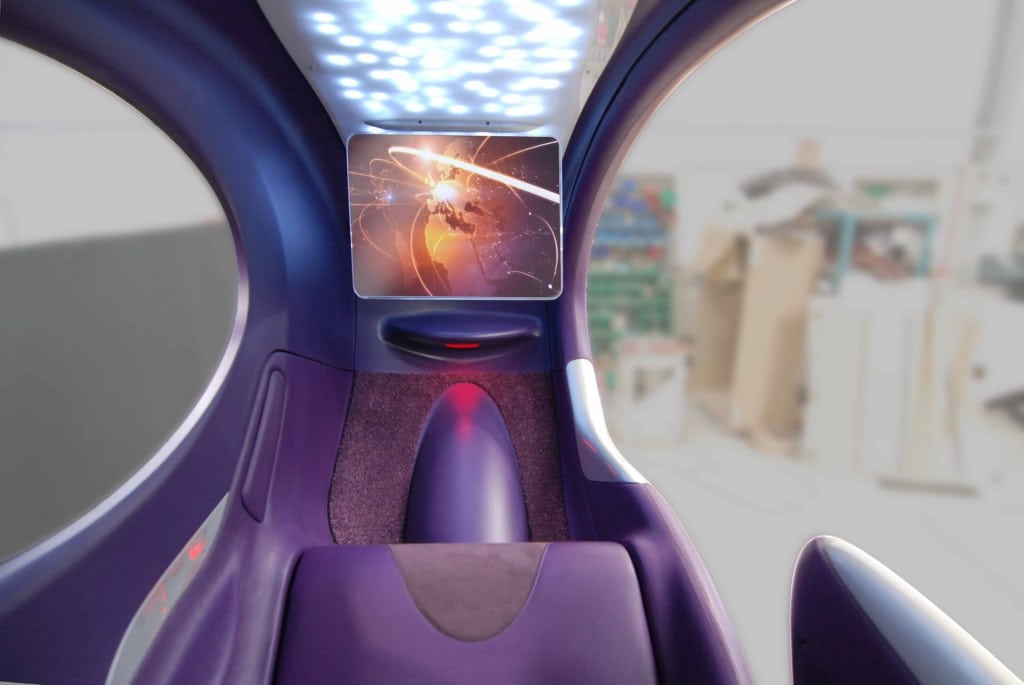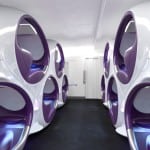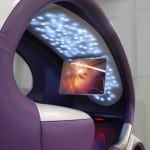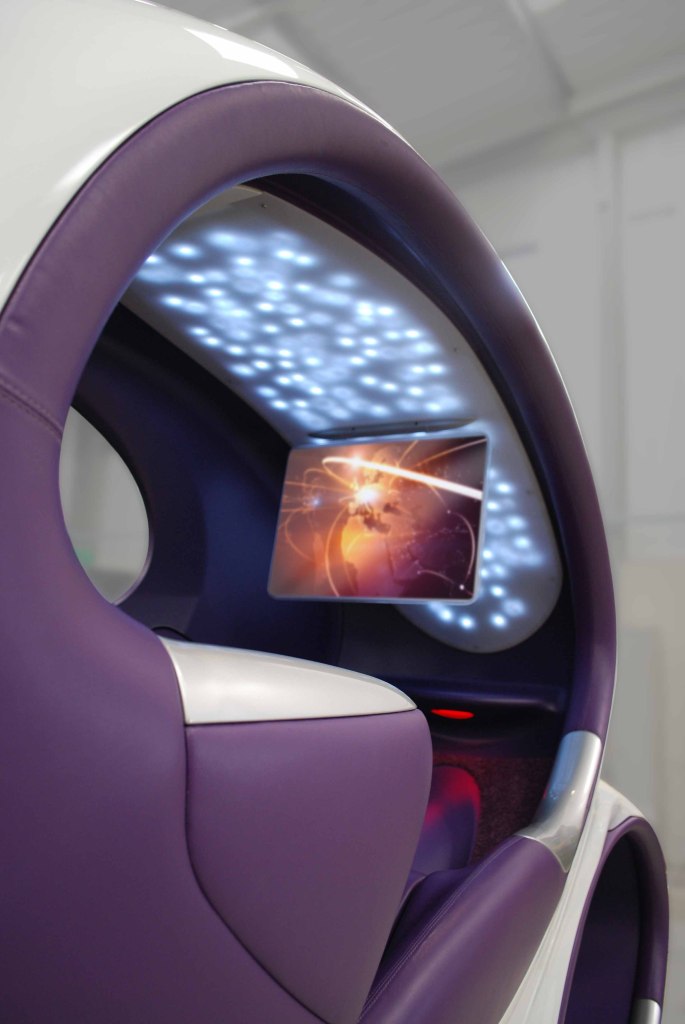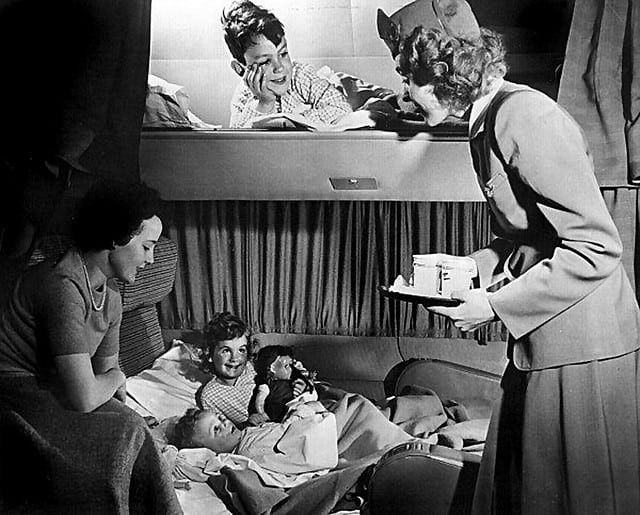Skift Take
We love the bold design thinking of the Air Lair 'This might just fly!' concept. But it could take a while for airlines to get over outdated 'class' thinking. Until then, it won't fly.
- Air Lair Seating Concept on A380 mid fuselage /Factorydesign
- Air Lair Seating Concept/Factorydesign
- Air Lair Seating Concept/Factorydesign
- Air Lair Seating Concept/Factorydesign
- Air Lair Seating Concept/Factorydesign
- Air Lair Seating Concept/Factorydesign
As Ben Orson, Managing Director of JPA Design told attendees at the Skift Forum this year, the next big trend in cabin design is 3-D seating. This design approach is defined as capitalizing on the vertical space of the aircraft to improve cabin density beyond what horizontal use of floor space can accomplish.
You may already have enjoyed a flight in a 3-D design cabin, and not even know it. The more conservative interpretations of this design philosophy already feature on select aircraft.
“There have been product concepts out there for years,” says Orson, “some of them quite wild, but the products which are entering the market now capitalize on vertical space in a way passengers will be barely aware of.”
Passengers wouldn’t know they sat on 3-D design seats because: “The most recent generation of these products look like conventional seats as the passengers enter the cabin,” Orson explains.
The principles of 3-D design applied to these seats involve overlapping the under-used space of one seat structure to benefit another. By stacking seat structures this way, less horizontal space is needed, allowing airlines fit more seats in the same cabin. For example, as applied in stacked footwell areas of lie-flat seats. “Overlapping of the footwells can allow for greater density,” Orson explains, “but with no need to reduce overall bed area. When you do go into the bed mode, the sensation is unremarkable and compares to other flat-seat designs. They’re far more acceptable proposals. The benefit of these types of seats is that they offer a further step change in space efficiency.”
The 3-D design trend also includes more out-of-the-box thinking. Forget boxy seat structures. Think pods instead.
The Air Lair, designed by Factorydesign, London, is the most innovative (and groovy) application of the 3-D design approach to make it to prototype.
Adam White, Director of Factorydesign, describes the process of imagining the cabin more like a honeycomb than a grid.
“When we were approached by Contour, now owned by Zodiac, to come up with ideas that led to the Air Lair concept, they specifically wanted us to create something outside the ordinary, something that would be new. But at the same time, we knew we wanted something that we felt had a genuine intelligence in terms of [use of space].” This is what Factorydesign accomplished with the Air Lair, nesting the upper passenger between the lower passengers, not one right above the other, making the overall height of the pod a viable structure to fit in an airplane.
Is the Air Lair awkward to get into? That was the first thing we asked. White says, not really. “Drivers quickly adapt to getting in and out of a Ferrari, if they’re lucky enough, or a van, or large 4X4. The seat heights of those more extreme vehicles are not dissimilar to the seat heights of the upper and lower positions of the Air Lair.” Factorydesign considered this seating process suitable and acceptable, when weighed against the benefits of passenger distribution.
White acknowledges the Air Lair seats are not suitable to all passengers, such as passengers with mobility restrictions. In fact, the firm considered these limitations in their proposal, and emphasized that the Air Lair seat was not a sole cabin option. As White explains: “Our recommendation was that this should be used in conjunction with standard First or Business seats.”
Factorydesign proposed another future trend when developing the Air Lair: eliminating cabin class. A number of designers have pointed out that the idea of passengers seated by class is outdated. They suggest cabins should move to sections dedicated to passenger needs instead: cabins for families, cabins for those flying to work, luxury cabins and cabins for singles, etc. White calls these zones.
“You would have an A-Zone, a B-Zone, maybe down to five or six different zones in an aircraft. [The Air Lair] would be a restricted zone and it’s restricted because the nature of the seating is different and therefore the activity is different. You would only want to be in an Air Lair pod if you wanted to have no contact with other passengers. It’s a seat for single people. It is a private space.”
Besides, the Air Lair was a concept seat. But, as White tells us, Factorydesign took (and takes) the concept seriously and considers it technically viable.
“It is correct that we were asked to do a purely conceptual design,” White says, “but for us, unless there was a possibility that it could be made..a degree of realism to the packaging and engineering, then it wouldn’t be something we would have wanted to pursue. When we created the design, we did a short investigation of how it would fit into aircraft on layout.”
“We did studies and found out it gave us a higher density than standard First Class seats in a like-for-like cabin space. It is a concept, but the Factorydesign codename for that project was: ‘This might just fly!’ We felt that any concept that we do has to be about having a vision and not just wild ideas.”
Orson believes the Air Lair concept deserves due credit for creative thinking. “It’s important to have a collection of thought-provoking design concepts,” he says. “It helps stimulate a dialogue from which new innovations will arise.”
Beyond the Air Lair blue sky proposal, Factorydesign has applied 3-D thinking to seats already in the air.
“We designed the very first concept Thompson Aero Vantage seat with Thompson,” White says. “Most recently launched is the Business Class seat for Aer Lingus this year, JetBlue’s Mint seat last year—both of which are seats that we’ve designed and styled. Plus a larger version called Vantage XL for SAS this year. The success of these seats is the overlapping of people, and use of the real estate from underneath the arm of one passenger for the seat of another.”
Orson and White point out that higher density 3-D cabin design is most suited to Business Class. But classes are becoming vague blurry things. Some airlines could market these seats as First Class.
Passengers who want an ultra-luxury experience won’t accept denser cabins. And that market exists, says White. “There will always be—even with the deepest financial depression we’ve seen in the past six or seven years—people who make money and are able to fly First Class,” he tells us. “I think that, at this point in time, you will see more activity and innovation in Business Class because the volumes are there and the numbers are higher. But, in First, what you see is an increasing effort to create a more exclusive space as witnessed by Etihad’s ‘The Residence’. ”
White would know. Factorydesign also contributed to the design of The Residence and the design of the Four Seasons Jet.
But demand is high for a mid-market premium flight experience, with lay-flat beds. These passenger preferences, Orson and White agree, will continue to drive the 3-D design trend.
“The key of Business Class is that you can lie flat,” says White. “There’s been a lot of activity for the last five or six years to reexamine [the cabin]. There is no substitute for getting more passengers into the same space, because revenue is key to an airline’s success and therefore its ability to pay for good design.”
“The new generation of design proposals for 3-D seating are broadly speaking, far more fitting to customers’ needs than their predecessors,” Orson says. “We don’t see any difficulties with passengers feeling uncomfortable with them, so long as the products are designed in such a way that the vertical adjustment is well managed. This new branch of seating innovation has the potential to either increase passenger numbers for a given comfort level or to increase comfort levels for a given passenger number; there is the potential for passengers to benefit in terms of reduced fares or greater comfort respectively.”
For anyone still concerned about being stacked on top of each other in the equivalent of flying bunkbeds, Orson has this to say: “Passengers should be reassured that there are a lot of checks and balances before any radical seat designs can make it onboard.”
We already had bunkbeds (berths) on planes, back in the ‘Golden Age’ of aviation. More recent stringent safety standards waved those dubious concepts goodbye.
The Daily Newsletter
Our daily coverage of the global travel industry. Written by editors and analysts from across Skift’s brands.
Have a confidential tip for Skift? Get in touch
Tags: american airlines, in-flight
Photo credit: The Air Lair seating concept. Factorydesign
